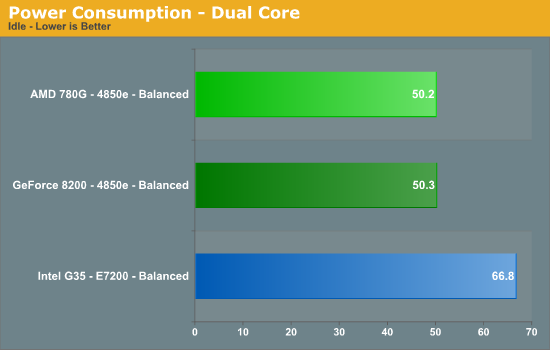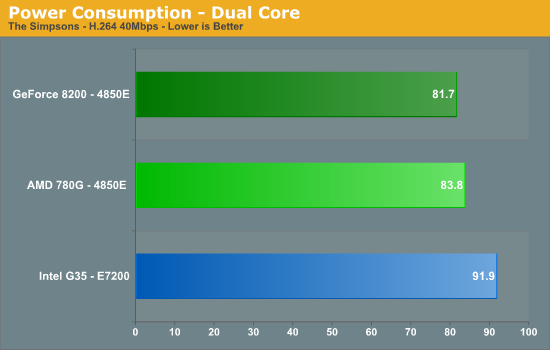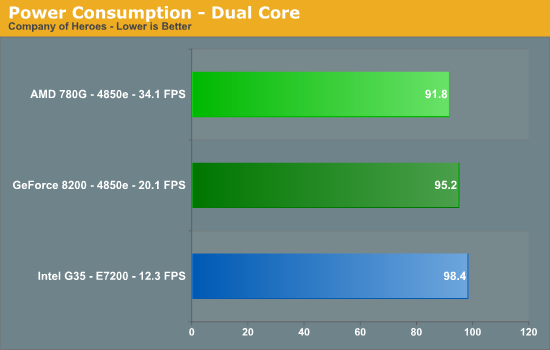We took a first look at power consumption numbers from the latest integrated graphics platforms and came away with some surprising results at the time. As we mentioned in the original article, our initial focus was on the platform and not chipsets. Little did we know the reaction this focus would create from both the manufacturers and readership. As expected, the chipset/processor manufacturers had their own opinions about our results and offered a wealth of information about their internal results and test practices.
We learned a great deal, about how Intel, NVIDIA, and AMD arrive at their reported numbers, but more importantly that each company arrives at their final results just a little differently. We will get into that subject matter and more in our first specific power consumption article. As for today, we are going to provide some quick results based on our current testbeds utilizing the AMD 780G, NVIDIA GF8200, and Intel G35 chipsets.
After completing power consumption numbers on twelve boards (results on Monday) featuring these latest chipsets, it became obvious that each manufacturer implements power management capabilities of the chipsets and processors in a variety of ways. Even testing the same chipset from two different board suppliers with like BIOS options resulted in measurable differences. Based on previous testing this was not a real surprise to us. However, after specifically focusing on power management capabilities the differences in options between each BIOS and even how standard features are implemented shocked us to some degree. At least to a degree that we will spend significantly more time and effort on reporting power management options and results in future articles.


In our first article, we utilized boards from different manufacturers, enabled each power option available in the BIOS and standardized Vista's power management schemes. Although each BIOS option appeared similar, the results turned out to be quite different between manufacturers. In fact, it was the power management features missing that provided the biggest differences between boards.
After weeks of discussion with AMD, Intel, and NVIDIA about the variety of power management options available in the core BIOS code and then comparing that information to what the supplier implements, we turned our attention to the board suppliers to provide significantly better power management features. Not only have most responded with improved features or performance, it also appears a greater emphasis from the chipset manufacturers is occurring at this time on new product releases.
As such, our testing today will utilize boards from Biostar for the AMD 780G and GeForce 8200 chipsets. The reason being is that most board suppliers will utilize like BIOS code and features along with components for their entry level boards in order to save costs. Biostar does not supply a G35 board so we will stick with our ASUS sample. ASUS also offers 780G/GF8200 boards that are very similar to each other in design and price. However, the current boards are being phased out. They will be replaced shortly by new boards with improved feature sets and the capability to handle 140W TDP processors.
The important point to make here is that 780G/GF8200 boards from Jetway and ASRock each had very similar BIOS options and board layouts that resulted in comparative numbers between these two chipsets. Our two Biostar boards do differ, as the 780G is a uATX format while the GF8200 is a standard ATX format board. However, the Biostar GF8200 board offered the best power consumption numbers in our roundup testing so we will use it as a best-case example. The same applies for the 780G board from Biostar.
Since our initial article, each board has received several BIOS upgrades along with significant driver changes from the chipset manufacturers. In doing A/B comparisons between each BIOS and driver change, we did notice improvements in power management for the Intel and AMD products while the NVIDIA numbers increased slightly due to additional performance and features provided by the latest driver set. We also changed our power supply, fan count, hard drive, and memory components to represent our standard test bed options for future articles.



At idle, the 780G and GF8200 basically tie now. In previous testing with the Gigabyte 780G board, the 780G was about 7W higher at idle than the Biostar GF8200. The Intel G35 dropped about 8W after the 0506 BIOS update along with a change in the retail cooler for the E7200. The H.264 playback numbers favor the AMD and NVIDIA chipsets as they feature hardware acceleration for H.264 that Intel is lacking until the G45 arrives. However, the Intel number did improve around 12W after the latest BIOS, driver, and PowerDVD Ultra updates. In our final test, the GF8200 performs the best from a pure wattage vantage viewpoint. The 780G actually has the best performance per watt rating based on a 70% increase in frame rates with only a 5% increase in power compared to the GF8200. The G35 is not recommended for most recent game titles so we will not even comment further on its results.
We will be back on Monday with a look at several different boards and further information about power management features along with performance per watt in additional titles. In the meantime, we were impressed with the attention Biostar has placed on power management in their IGP boards along with the improvements of our G35 board after a series of BIOS and driver upgrades.










30 Comments
View All Comments
KnightProdigy - Thursday, June 19, 2008 - link
Seems we get fanbois crawling out of the woodwork when one platform beats another.I recall the entire decade that AMD had beat intel in every aspect. Intel has the crown back for a year or two and its hail to the empire.
Pathetic if you ask me and just plain sad.
The article clearly compared for you, apples to apples in the respect that this is what is currently offered in the consumer desktop arena for low power consumption. It doesn't matter that the C2 is 65w or not, that is what Intel is offering with the G35 as their low power consumption.
Does the atom work with a G35? As far as I know, no. So this is what you have, apples to apples to apples.
Considering the performance increase you get with the 780G or 8200 the AMD solution here is just better. When you want high end mainstream graphics and performance, go Intel with an NV graphics card.
Zoomer - Saturday, June 21, 2008 - link
Besides, even if the atom could interface with the G35, I doubt it would be able to handle the 1080p video decode.Einy0 - Thursday, June 19, 2008 - link
I just built my mom a new rig she had to have Vista, but she's not a gamer at all. Unless you consider Mahjong or solitair gaming. I've seen Intel IGPs in Vista and they suck. Price was a huge factor for her, so I decided to take a shot on the 780G. I haven't been impressed with Nvidia's IGPs since the 6150 came out. They've been the same thing since with different names. I have to say the 780G has surprised me. It's a performer and stability is rock solid too.chucky2 - Wednesday, June 18, 2008 - link
Gary,I know it'll be a little bit more work, however it'd really be nice to see at least one 690G board represented in these tests. The Gigabyte mATX -S2H board or their full ATX -S3H board would be good options.
If nothing else, it lets us see how much 780G has improved of 690G, and also for us 690G folks, we can see how our current builds stack up to these newer platforms.
Chuck
iwodo - Wednesday, June 18, 2008 - link
So bascailly ATI offers the best Power / Performance with their IGPAnd Intel = useless junk that is slowing the industry moving forward.
tshen83 - Thursday, June 19, 2008 - link
No, basically you got fooled by Gary Key's article. 4850e is a low power CPU with TDP of 45W while the 7200 Core 2 Duo is a 65W part. So there is a 20W difference from the CPU alone, which means the G35 draws less power than 780G. On the other hand, the 7200 is a far more powerful CPU than the 4850e. (30% CPU difference). And 8200 and 780G is a little better GPU than G35.Gary, I am a little disappointed by your article of fudging the truth of comparing a 45W cpu with a 65W CPU in a GPU power consumption article. You should know better.
Spoelie - Thursday, June 19, 2008 - link
You don't believe those 45w and 65w figures are actual continuous consumption figures, do you?? In fact, the ahtlon is built on a 65nm process, while the core uses a 45nm process. The core should consume less.You got something mixed, the 8200 and 780 are far more powerful than G35 as well.
Calin - Monday, June 23, 2008 - link
With everything said, the Core2Duo might indeed use more power than the low power Athlon.However, the integrated graphics from Intel are a joke when 3D games are involved - going down to even 10% from the GeForce 8200 or AMD 780G.
tshen83 - Thursday, June 19, 2008 - link
You think I don't know the process used to build the chips? An athlon built on 65nm process does not necessarily run hotter than 45nm core 2 duo process. It is all about current leakage at the speed in which the chip runs at. No, the 7200 consumes more than the 4850e, by about 10-20W(20W at peak) When you add 20W to the figures you can see that the figures at completely reversed.I agree that 8200 and 780G is more powerful than G35. That's why they draw more power too. What I have pointed out is that gary used a 20W differential in peak CPU consumption to fudge the GPU power consumption charts.
tshen83 - Thursday, June 19, 2008 - link
if you don't believe me, ask Gary to put up an Apples to Apples comparison by using a 65W 65nm Brisbane Athlon x2. Results will surprise you.